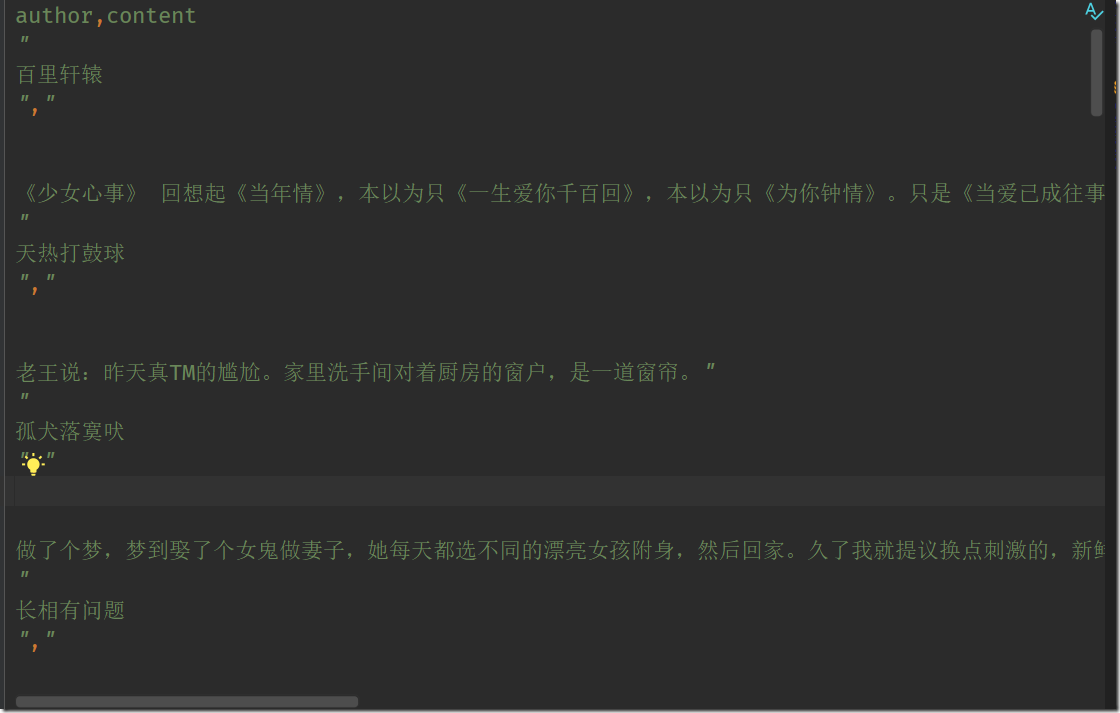从存储方式上分为2种,存入磁盘和数据库。
如下是原始的爬虫代码
# -*- coding: utf-8 -*-
import scrapy
class FirstfileSpider(scrapy.Spider):
name = 'firstfile'
start_urls = ['https://www.qiushibaike.com/text/']
def parse(self, response):
# 使用框架的xpath接口
list_div = response.xpath('//div[@id="content-left"]/div')
for div in list_div:
author = div.xpath("./div/a[2]/h2/text()").extract()[0]
content = div.xpath("./a/div/span/text()").extract()[0]
a.磁盘文件
1.基于终端指令的持久化存储
首先保证parse方法返回一个可迭代类型的对象(存储解析到的页面内容),再使用终端指令完成数据存储到制定磁盘文件中的操作。代码修改如下
# -*- coding: utf-8 -*-
import scrapy
class FirstfileSpider(scrapy.Spider):
name = 'firstfile'
start_urls = ['https://www.qiushibaike.com/text/']
def parse(self, response):
# 使用框架的xpath接口
list_div = response.xpath('//div[@id="content-left"]/div')
# 存储解析到的页面数据
data_list = []
for div in list_div:
author = div.xpath("./div/a[2]/h2/text()").extract()[0]
content = div.xpath("./a/div/span/text()").extract()[0]
res_dict = {
"author": author,
"content": content,
}
data_list.append(res_dict)
return data_list
终端输入参数为:scrapy crawl 你的文件名 –o test.csv
当然你也可以用其他的格式。在打开test.csv可以看见结果。
2.基于管道的持久化存储
如同Django里面的models一样,items.py用来设置数据存储模版,结构化数据。pipelines用来数据持久化处理。总的来说就是items先存储解析到的页面数据,然后pipelines处理持久化存储的相关操作.
代码的实现流程:
1.将解析到的页面数据存储到items对象
2.使用yield关键字将items提交给管道文件进行处理
3.在管道文件编写代码完成数据存储的操作
4.在配置文件中开启管道操作
firstproject(爬虫文件名字).py
# -*- coding: utf-8 -*-
import scrapy
from firstproject.items import FirstprojectItem
class FirstfileSpider(scrapy.Spider):
name = 'firstfile'
start_urls = ['https://www.qiushibaike.com/text/']
def parse(self, response):
list_div = response.xpath('//div[@id="content-left"]/div')
for div in list_div:
author = div.xpath("./div/a[2]/h2/text()").extract()[0]
content = div.xpath(".//div[@class='content']/span/text()").extract()[0]
print(author)
print(content)
# 1 存储到items对象
item = FirstprojectItem()
item['author'] = author
item['content'] = content
# 2 提交给管道
yield item
items.py
import scrapy
class FirstprojectItem(scrapy.Item):
# define the fields for your item here like:
author = scrapy.Field()
content = scrapy.Field()
pipelines.py
class FirstprojectPipeline(object):
fp = None
def open_spider(self, spider):
# 该方法再整个流程中被调用一次
print("开始爬虫")
self.fp = open("./test.txt", "w", encoding="utf-8")
# 爬虫每向管道提交一次item,该方法就会被执行一次
def process_item(self, item, spider):
ITEM_PIPELINES = {
'firstproject.pipelines.FirstprojectPipeline': 300,
}
# item就是接受到的item对象
author = item["author"]
content = item["content"]
# 持久化存储操作
self.fp.write(author+":"+content)
return item
def close_spider(self, spider):
print("爬虫结束")
self.fp.close()
settings.py中添加这一行
ITEM_PIPELINES = {
'firstproject.pipelines.FirstprojectPipeline': 300,
}
b.数据库
代码流程:类似于管道持久化,区别就是pipelines文件中持久化方式的区别
1.基于mysql持久化存储
在上面的基础上修改下pipelines文件,其他注意提前在mysql创建好相应的表的列和行
import pymysql
class FirstprojectPipeline(object):
conn = None
cursor = None
def open_spider(self):
self.conn = pymysql.Connect(host="127.0.0.1", port=3306, user='root')
def process_item(self, item, spider):
# item就是接受到的item对象
author = item["author"]
content = item["content"]
sql = 'insert into qiubai values ("%s","%s")' % (author, content)
self.cursor = self.conn.cursor()
try:
self.cursor.execute(sql)
self.conn.commit()
except Exception as e:
print(e)
self.conn.rollback()
return item
def close_spider(self):
self.cursor.close()
2.基于redis存储
由于windows对redis支持不友好,所以我们这里在Linux上开发。非分布式的爬虫在这里实际上和基于mysql只有pipelines文件的区别。
首先开启好redis服务,再连接即可。注意这里的python的redis模块使用的是2.10.6版本。使用命令pip3 install redis-2.10.6来回退版本。
import redis
class FirstprojectPipeline(object):
conn = None
def open_spider(self, spider):
print("start spider")
self.conn = redis.Redis(host="127.0.0.1", port=6379)
def process_item(self, item, spider):
my_dict = {
"author": item['author'],
'content': item['content'],
}
print(my_dict)
try:
self.conn.rpush("my_data", my_dict)
except Exception as e:
print(e)
return item
然后在终端输入redis-cli开启客户端,输入hgetall my_data查看是否写入即可。可能会抽风,等待下网络即可。
